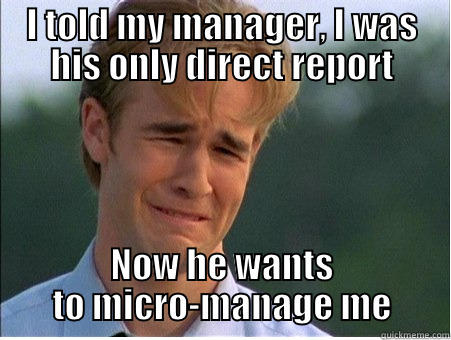 How many direct reports is the most effective for a leader? How many direct reports is the most effective for a leader? Structure your team for success with the right view of span of control, interactions and direct reports. When an organization grows beyond the one-person operator delivering goods and/or services out of their garage, the process of building systems for success becomes essential to long term health. What works as a small company has to evolve as the company grows or the organization will outgrow the preceding systems. As an organization grows, adapts, changes and evolves, one question every leader and organizational system must answer is how many direct reports any given person in a position of leadership should have. At the end of the day this question has no right answer given that each organization is unique and each manager has a different threshold for efficacy. Let’s take a look at some of the metrics, discussions and insights related to the topic of finding the right number of direct reports. Gauging interactions (energy output) How do you measure efficacy when assessing the right number of direct reports? Business Insider took a peek at the number of reports of Tim Cook, the COO made CEO of Apple, who was believed to have upwards of 17 direct reports. Hal Gregersen, Ph.D., the executive director of the MIT Leadership Center states, “It's a question of how many people a leader can have a constructive conversation with when everyone is in the same room (Lebowitz, 2015).” Time is a limited resource that every manager only has so much of and trust is the greatest asset in developing employee engagement in an organization, the question is not how thin can a leader stretch themselves but how effective they can be in leading the members of their team whether directly or indirectly. Business journals and many persons in a position of leadership (PIAPOL) site Japanese management philosophy and regard 6-7 direct reports as the maximum number that a leader can effectively manage. In his own defense, Tim Cook emailed a response to Business Insider countering that, “"If you have smart people, a strong organizational culture, and a well-defined and articulated strategy that everyone understands, you can [have] numerous direct reports because your job isn't to tell people what to do.” Whether those analyzing a leader from within the organization or from the outside agree with the direction and decisions that they make, at the end of the day they will rise or fall based upon how they approach their leadership responsibilities. Measuring span of control So much of this discussion on the optimum number of direct reports is opinion based, one metric cited by Schaffer Consulting remarks that span of control is something which can be measured in this discussion, “When a manager goes from four to five subordinates, his potential interactions with them increase from 44 to 100 over a given period; and going from seven to eight subordinates raises the total interactions from 490 to 1,080 (Inc.).” This is a classic business concept that continues to be of relevance and value to organizations such as the United States Air Force in their goal of focusing missional clarity. Size of the organization obviously comes into play and the overall structure of a team must be crafted to support it’s necessary functions as well as it’s growth goals. As for the ethereal question "What is the right span of control for a manager," a consultant Jamie Flinchbaugh blogged, "Some factors to consider are: The narrower the span of control, the more coaching at the point of activity can be done; the broader the span of control, the more the entire process can be encompassed within fewer decision makers and more aligned decisions (The Build Network, 2014).” This is a simplified means of looking at the bigger picture, but a leader must analyze the position they are in with regards to the development of their organizational structure to determine where their immediate efforts are most valuable. Does the leader need to be directly involved in the training of key share holders in the building process or do they need to take a few steps back from the process to empower those on their leadership team to take ownership for their areas of responsibility. Avoiding top heavy management If the number of direct reports is too low, because the team has built multiple layers of upper and middle management to insulate those in positions of executive leadership there is a potential for disconnect. When an organization becomes slow and top heavy by way of structure, there are too many layers to weave through in order to accomplish anything in a timely or mission centered manner. As far back as 1989, Jack Welch, the CEO credited with turning GE around, was an advocate against the six direct report rule for many of these reasons. In an interview with Harvard Business Review, the management guru shared his candid thoughts on the matter, “We took out management layers. Remember the theory that a manager should have no more than 6 or 7 direct reports? I say the right number is closer to 10 or 15. This way you have no choice but to let people flex their muscles, let them grow and mature. The leader can focus only on the big important issues, not on minutiae (Tichy & Charan, 1989).” Systems should be built to support the people in the field who are making the products and/or delivering the services that make up the core functions of the organizations value interaction with the market. The question of the right number of direct reports is not a matter of ego nor strictly of science, but rather is a key discussion that will evolve with the needs of the organization in a manner that is unique to that team. Mike Myatt, Forbes contributor and chairman of N2 Growth, shares, “Where many leaders become disoriented is by confusing platform with people, and position with responsibility. Here’s the thing – it’s not about the platform, it’s about the people. Without the people there is no platform, and ultimately nothing to lead. It’s not about you (the leader), but what you can create and influence through those you lead (Myatt, 2012).” Rather than looking for the perfect number of direct reports, a leader should ask how many people they can effectively support to keep the vision and mission of the organization moving forward with relationship to the team’s values. Clarity. Consistency. Accountability. References: Lebowitz, S. (July 8, 2015) Apple CEO Tim Cook now has 17 direct reports – and that’s probably too many. Business Insider. Retrieved from http://www.businessinsider.com/apple-ceo-tim-cook-has-too-many-direct-reports-2015-7 The Build Network (April 3, 2014) Wait, how many reports direct reports did you say you have? Inc. Magazine. Retrieved from https://www.inc.com/the-build-network/direct-report-challenges.html Tichy,N., Charan, R. (October 1989) Speed, simplicity, self-confidence: An interview with Jack Welch. Harvard Business Review. Retrieved from https://hbr.org/1989/09/speed-simplicity-self-confidence-an-interview-with-jack-welch Myatt, M. (November 5, 2012) Span of control – 5 things every leader should know. Forbes. Retrieved from https://www.forbes.com/sites/mikemyatt/2012/11/05/span-of-control-5-things-every-leader-should-know/#7f921b0328c8
0 Comments
 Communication lines need to be clear and direct Communication lines need to be clear and direct Originally published as Peeling Back the Five Layers of in a Restoration Business June 22, 2016 in Restoration & Remediation Magazine (R&R) By Jon Isaacson How many times a day does the phone ring and it's a customer calling wondering when your organization is going to get the work done, when the crew is going to arrive or what the schedule is? Is it more often than it should be? Who holds the responsibility in the organization to communicate these details to your customers? Before we start to point fingers, let's follow the sequence of information. Organization Layer 1 Our customer called the office because they have not been communicated with, the last person at the job was an employee who was there over 48 hours ago. We ask, why didn't that employee tell the customer what the next sequence of work was going to be? At the conclusion of our investigation into Layer 1, we are ready for a heated discussion with our lead technician assigned to the project. We say our organization values our customers, but we are not demonstrating this with clear and consistent communication. Organization Layer 2 We track down the responsible employee who was last at our under-informed customer's home and it turns out that employee didn't communicate scheduling details with the customer because that employee was not provided with sufficient information to intelligently pass along to our customer. While we were prepared to discipline this employee as the source of miscommunication, we discover that there are additional parties involved with this malady - there are more layers to investigate. In addition to this discovery, our employee brings to our attention that they regularly don't know what they are doing for the day when they show up for work. As an organization we would say we value our customers, we also would say that we value our employees, we may even have these values posted on our walls, and yet we are not communicating with clarity or consistency to either party. Organization Layer 3 As a manager, the frustration is turning is now bordering on anger. We march forward to discuss these disturbing findings from the previous two layers with our employee's supervisor. Rather than uncovering the head of the snake, we reveal that our production supervisor hasn't been clearly or consistently communicating scheduling or work details because they haven't been receiving them from their supervisor (in most restoration companies we are now at the estimator level/layer of the org chart). Our production team hasn't been communicating in the manner we would expect with customers or employees because they are flying by the seat of their pants with the work being handed down to them. We are uncovering that our issues are as much with systems as they are with persons. Organization Layer 4 Each layer has revealed an additional layer, managers who are willing to investigate may now be fearful of encountering additional worm holes within the system. Not us, we continue our investigation and gather the estimators into the conference room for the final tongue lashings. As a related side note, everyone serving in the 24/7 emergency response industry knows that work comes in at all times, in all sizes and has no mercy with regards to holidays or special occasions, yet just because we service emergencies does not mean that we shouldn't have as clear a process that we can develop. Our management team unravels the layers of investigation stemming from the call received by our confused customer, the estimators relate their challenges in working with how the work flow is initiated. Work flow with relationship to how assignments are handed out, especially when our organization is serving the needs of clients who are all in various degrees of distress, is essential to setting our teams up for success. We are faced with a reality that our response process may be broken or at least damaged and needs some TLC in order for our team as a whole to be successful. If we value our customers and we value our employees, we need a system that communicates with clarity and consistency. Organization Layer 5 The investigation goes full circle and we have determined that there are issues related to a lack clarity and consistency in the work flow process which is affecting us at every level. In order to fix this, we will need to address the system from top to bottom and will need every layer of our organization to be invested in the restoration of our process. Communication is our organization showing our customers that we value them. Clarity and consistency is our organization showing our employees that we value them. Scheduling is the result of a commitment to preparation for success and a successful scheduling system enables everyone on our team to communicate with clarity as well as consistency. Our efforts to create a system of clear and consistent communication from start (receiving a request for service) to completion (creating a happy customer) will require intentional efforts as a workable schedule will not create itself. The reason we spent all these words (all this time) just to establish the problem, is that while scheduling should be the foundation for any service organization, the commitment to clarity and consistency is rather uncommon. Often we get so wrapped up in the emergency nature of our business, that we forget to build around our values. When a customer calls with a valid complaint, this is an opportunity for some honest organizational evaluation as well as a wake up call for action. What Must We Do? Property restoration as an industry requires multiple aspects of technical knowledge in our fields of multiple service offerings as well as communication of multiple work details across multiple data entry points to keep multiple parties involved with a given loss updated on work progress. Clarity At The Point Of Work Intake Do we have a consistent process for gathering as much information as we can when a call for service comes in? Regardless of who answers the phone, we should have a clear and consistent process for acquiring the details necessary to set our teams up for success. When we answer the phone, we communicate to our customers that we care by getting the details right and we communicate to our service employees that we care by providing them with the details they need to start a project off with good information. Clarity At The Point of Work Initiation The reality In emergency response to disasters, work comes in at all hours of the day as pipes break, fires occur or a host of other scenarios play out for homes and businesses in our area. Because of these contingencies, our schedules can never be fixed to the point that they cannot change at a moments notice. As such we always have to build into our schedules a certain amount of flexibility. Our production managers have to be aware that they cannot send all of our resources to the furthest reaches of our service territory and still be able to reallocate personnel to respond in the middle of the day to a customer that is in need of emergency services. We have to be honest with our customers about what we can and cannot do as we have to fulfill our prior commitments while evaluating our abilities to service new ones. Being busy is a good problem for any organization, this usually means we are growing, but being chaotic is unhealthy and will lead to failure. Clarity Within The Organization Establishing a visible joint schedule for our organization is an essential means of assisting all of our teams to prepare for the day ahead while enabling us to update our customers with our strategy for keeping their project moving forward (read our previous article about visible schedules HERE). Our people deserve to know, as best as management is able to communicate, what their assignment will be for the following 24 hour period so that they can mentally prepare and ready their teams to respond to our customers needs. Our customers deserve to have consistent communication of job progress and to know when strangers are going to be in their home. Find the medium that works for your team, but make the schedule accessible and visible by all in the organization as this creates great accountability through transparency. When the concerned customer calls to ask about their job, the person answering the phone should be able to say, "Let me pull up the schedule. Yes, I can see we are scheduled to be at your home between 11am and 12pm today, would you like me to get ahold of the technician who will be responding or the project manager assigned to your loss?" Clarity Within Your Work Communication For our team, we inherited a system of carbon copies for printed work orders (or field scopes). Carbon copies served a purpose at some point in time...a point in time right around when the dinosaurs became extinct. We were able to adapt our hand printed work orders (penmanship is a barrier to clarity) into a Microsoft Excel format so that they could be typed - allowing us to ensure they were readable and savable which allows us to track and reference these forms. The first order of the work order is that in order to be effective the work order must be legible, must have sufficient details and must be executable by the team members assigned to the tasks. Notes on a piece of paper are useless unless those composing the document have been intentional to be clear with those who will be touching the project. As our system for work orders evolved we wanted our system to be easier to input and more readily shareable by our entire organization. We needed a medium that would allow team leaders to communicate effectively with team members the details of work scopes and resource allocation. We looked into mobile and desktop applications as well as cloud based systems, most of the ones that were the most appealing were also fairly expensive. We experimented with free versions of popular systems but found many of them to be a time consuming venture that did not have the return that we needed, especially with our shorter term projects. Our schedule needed to show management where our fleet would be assigned, which personnel would be responding to an assignment and what production tools would accompany that crew to complete their tasks. We found that some of the best resource were those that we were already utilizing (see a fun video we made introducing our simple systems HERE). Google calendar is an effective means of creating a shared calendar that could be viewed by anyone in the organization at any time with features such as assigning a color to individuals to enhance the ease of visual review. (We gladly borrowed this aspect from a local plumbing company who showed us their production system). Through the shared calendar, each technician had an email that would show up in their email as well as their calendar with details such as the job address (which assists with OSHA compliance), the job number, contact information for the customer and a detailed scope of work written out for each day in the body of the calendar notes. Team members that wanted printed copies for their folders could have those in their hands and those that were savvy with their mobile devices always had records for reference. Each organization is unique, for us the values we are building around are: 1. Our schedule should be visible - anyone in our organization should be able to see where our resources are assigned at any given time (to the best of our ability) 2. We want to show our customers that we value them by being clear with our communication 3. We want to show our team members that we value them by being clear and consistent with our scheduling Clarity and consistency in communication requires the commitment of everyone in the organization, top to bottom - from the point of receiving a call for service to the completion of a project. We have to be intentional about improving our systems as the systems (good or bad) do not create themselves. Our systems may never be perfect, but we will reap what we sow. If the phone rings more often than it should with confused or upset customers, follow the layers to yourself and get to work on fixing the problems with the system. |
AuthorThoughts on personal and professional development. Jon Isaacson, The Intentional Restorer, is a contractor, author, and host of The DYOJO Podcast. The goal of The DYOJO is to help growth-minded restoration professionals shorten their DANG learning curve for personal and professional development. You can watch The DYOJO Podcast on YouTube on Thursdays or listen on your favorite podcast platform.
Archives
March 2023
Categories
All
<script type="text/javascript" src="//downloads.mailchimp.com/js/signup-forms/popup/unique-methods/embed.js" data-dojo-config="usePlainJson: true, isDebug: false"></script><script type="text/javascript">window.dojoRequire(["mojo/signup-forms/Loader"], function(L) { L.start({"baseUrl":"mc.us5.list-manage.com","uuid":"b9016446bd3c6a9f0bd835d4e","lid":"83282ffb9e","uniqueMethods":true}) })</script>
|
Jon Isaacson |
Connect. Collaborate. Conquer.
© COPYRIGHT 2015. ALL RIGHTS RESERVED.
|



 RSS Feed
RSS Feed